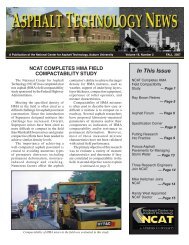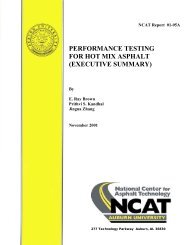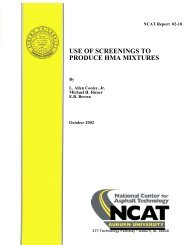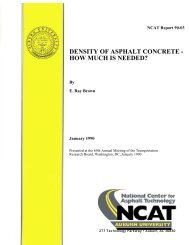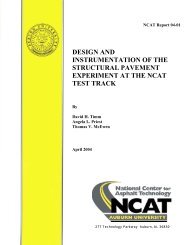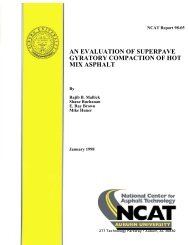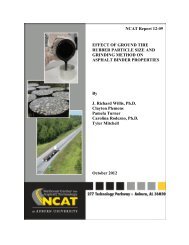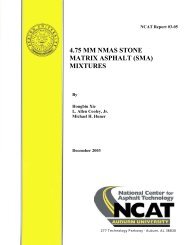A Review of Aggregate and Asphalt Mixture Specific Gravity ...
A Review of Aggregate and Asphalt Mixture Specific Gravity ...
A Review of Aggregate and Asphalt Mixture Specific Gravity ...
Create successful ePaper yourself
Turn your PDF publications into a flip-book with our unique Google optimized e-Paper software.
3 BULK SPECIFIC GRAVITY OF AGGREGATEBulk specific gravity is defined as the ratio <strong>of</strong> the weight <strong>of</strong> a given volume <strong>of</strong> aggregate,including the permeable <strong>and</strong> impermeable voids in the particles, to the weight <strong>of</strong> an equalvolume <strong>of</strong> water. Bulk specific gravity <strong>of</strong> aggregate is important information fordesigning HMA because it is used to calculate VMA <strong>and</strong> VFA. Since differentprocedures are used to determine the G sb <strong>of</strong> coarse <strong>and</strong> fine aggregate, this section isdivided into two parts, one for coarse aggregate <strong>and</strong> one for fine aggregate.3.1 Coarse <strong>Aggregate</strong> Bulk <strong>Specific</strong> <strong>Gravity</strong>3.1.1. St<strong>and</strong>ard Test MethodsThe st<strong>and</strong>ard test methods used for the determination <strong>of</strong> specific gravity <strong>of</strong> coarseaggregate are described in AASHTO T 85 <strong>and</strong> ASTM C127. The methods are essentiallythe same, except for the required time in which a sample <strong>of</strong> aggregate is submersed inwater to essentially fill the pores. While the AASHTO st<strong>and</strong>ard requires the sample beimmersed for a period <strong>of</strong> 15 to 19 hours, the ASTM method specifies an immersed period<strong>of</strong> 24 ± 4 hours. After the specimen is removed from the water, it is rolled in an absorbenttowel until all visible films <strong>of</strong> water are removed. This is defined as the saturated surfacedry(SSD) condition. Three mass measurements are obtained from a sample: SSD mass,water submerged mass, <strong>and</strong> oven dry mass. Using these mass values, the G sb <strong>of</strong> anaggregate can be determined.3.1.2. Precision Estimates <strong>of</strong> St<strong>and</strong>ard Test MethodsEven though the two st<strong>and</strong>ard methods require different saturation periods, the precisionindices are the same, as shown in Table 1.TABLE 1 AASHTO T 85 <strong>and</strong> ASTM C127 Precision EstimatesAcceptable Range <strong>of</strong>St<strong>and</strong>ard Deviation(1s)Two Results(d2s)Single-operator precision:Bulk specific gravity (dry) 0.009 0.025Multilaboratory precision:Bulk specific gravity (dry) 0.013 0.038Precision estimates for the st<strong>and</strong>ard coarse aggregate G sb test methods are alsodetermined annually by the Pr<strong>of</strong>iciency Sample Programs <strong>and</strong> reported on the AMRLwebsite (1). These precision indices are shown in Table 2. The precision estimates from1998 through 2005 vary significantly from year to year due partially to the use <strong>of</strong>different aggregate sources in the program. The precision estimates from the pr<strong>of</strong>iciencyprogram are greater than the precision estimates cited in the st<strong>and</strong>ard test methods (Table1). Since 2006, the Pr<strong>of</strong>iciency Sample Programs have used a different method <strong>of</strong>3




